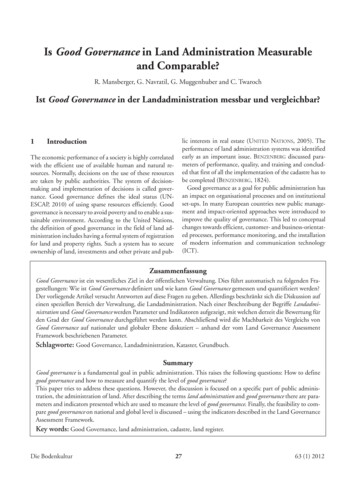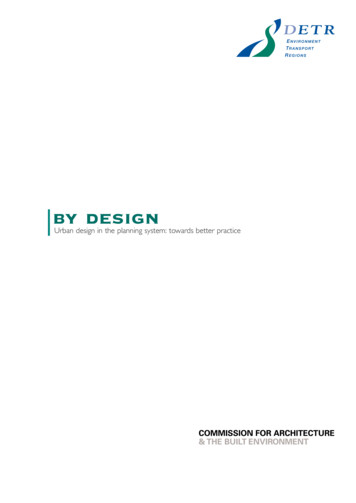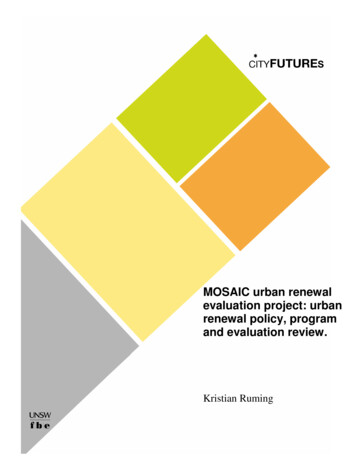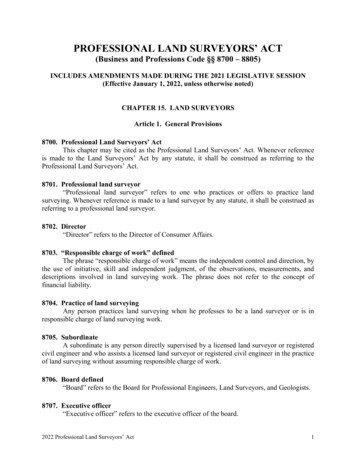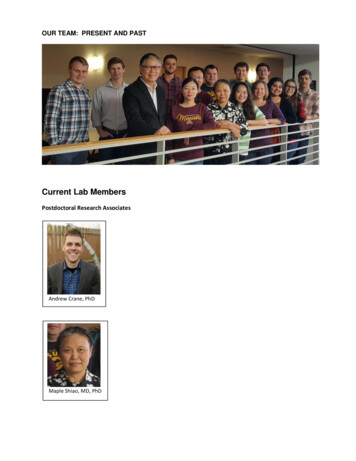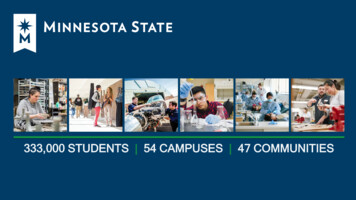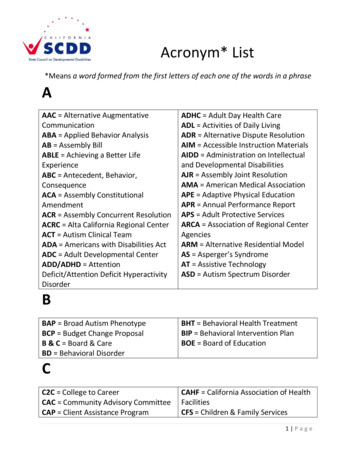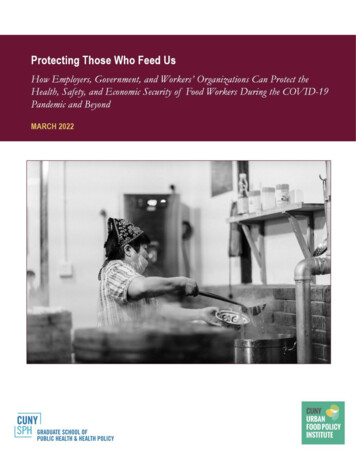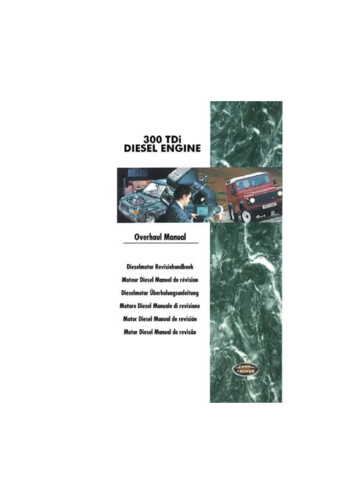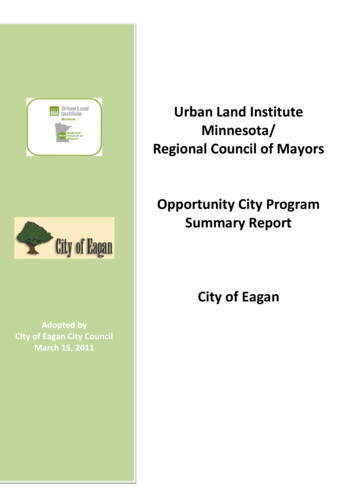
Transcription
Urban Land InstituteMinnesota/Regional Council of MayorsOpportunity City ProgramSummary ReportCity of EaganAdopted byCity of Eagan City CouncilMarch 15, 2011
ULI Minnesota & the Regional Council of MayorsUrban Land Institute (ULI) Mission:ULI provides responsible leadership in the use of land and in the creation of thrivingcommunities worldwide.Urban Land Institute Minnesota (ULI MN):ULI Minnesota actively engages public and private sector leaders in land use planning and realestate development to learn, network and join in meaningful, strategic action. The future holdsmany challenges and opportunities; we need the diversity of ULI Minnesota’s professionalcommunity to meet them wisely.Regional Council of Mayors (RCM)Supported by ULI Minnesota, the nationally recognized Regional Council of Mayors representsMinneapolis, Saint Paul and 42 municipalities in the developed and developing suburbs. Thiscollaborative partnership provides a nonpartisan platform that engages mayors in candiddialogue and peer-to-peer support, and builds awareness and action for a more connected,more sustainable and more prosperous region.Table of Contents Opportunity City Pilot Program Summary - Eagan’s Story . Page 3 Housing Audit Process . Pages 4–7- City Housing Goals & Policies. Page 4- Evaluate Community Factors . Page 4- Program Review . Page 5- Community Change Report Key Points . Page 6- Site Evaluation Summary . Page 7 Recommendations. Page 8–10 Next Steps . Page 11 Sponsors & Program Participants . Page 12 Appendix - Includes background information surrounding all aspects of the housingaudit process and detail on the review of housing programs, community change data,site review and examples of best practices.2
Opportunity City Pilot Program ReportSummary – Eagan’s StoryEagan's StoryThe City of Eagan is a nearly fully developed, vibrant community conveniently located in the southeast Twin Cities areaalong two major interstates. Eagan is a relatively large suburban community with a total population of65,933 people,encompassing approximately 34 square miles or 21,000 acres. Its close proximity to both downtown Minneapolis and St.Paul, and location near the international airport have contributed to Eagan having one of the largest and most diverseemployment bases in the region. The relationship between Eagan's large employment base and its housing needs areimportant to the City's future stability and economic prosperity.Program Goals/Outcomes:The goal of the Opportunity City Program is tobuild on the collaborative relationships amongRegional Council of Mayors (RCM) and UrbanLand Institute (ULI) professionals to identifyand implement best practices that support afull range of housing choices for economicstability and regional prosperity.The City of Eagan is one of seven metropolitansuburban communities selected to participatein the ULI MN/RCM Opportunity City Program.Eagan’s Mayor, Mike Maguire, is an activemember of the Regional Council of Mayors.The City of Eagan committed 5,000 to theOpportunity City Program as well as countlessstaff hours in the collection of information,evaluation of tools and strategies, andcoordination of the housing audit.By working together and learning from eachother, the expected outcome of the process isto develop an approach that identifies localhousing tools and strategies that can serve asa model for other cities and be brought toscale at the regional level. In addition,suburban cities can implement new tools andstrategies to better prepare themselves forthe future through: 1.) preservation,rehabilitation and production of qualityhousing units; 2.) use of regulatory incentives;3) incorporating sustainability into land useplans; and 4.) connecting housing to jobs andtransportation networks.Historically, a large percentage of Eagan's homes wereconstructed from the 1970's to early 1990's. With the completionof Interstate 35E in the mid 1980’s, major commercialconcentration formed near the center of the City. Theconstruction of Highway 77, a new Minnesota River bridge, andInterstate 35E accelerated the growth of the community.Development of townhomes, condominiums, and single familyhomes boomed during the 1980s and early 1990s.As the senior population living in Eagan has increased, residentialdevelopment geared toward “empty nesters” and seniors hasbecome more common. This has resulted in a decrease inpersons per household and school- age children.Even though the City has a wide range of housing choices, homesand residents are beginning to age, which presents challengesrelated to the need for increased maintenance and ability todiversity the City's housing stock to be attractive to youngfamilies and young professionals.Eagan has a strong history and policy of working with otheragencies to achieve community goals. In particular, the City'srelationship with the Dakota County Community DevelopmentAgency will continue to be essential in addressing future housingneeds as the County continues to develop, preserve andadminister housing programs in support of a full range of housingchoices.With the ability to guide redevelopment to diversify the housingstock, the City is in a good position to provide housing optionsthat meet the needs of young professionals and older residentswanting to stay and thrive in the community.3
Housing Audit Process: Housing Goals/PoliciesEvaluate Community FactorsEvaluate Community Factors:The Housing Audit Process:In every city, there are internal and external factors thathinder the city’s ability to provide a full range ofhousing choices. In Eagan, a few factors were evident,as determined through interviews with staff, planningcommission, city council and review of city materials.1.) Review of the housing framework: goals andcommunity factors.2.) Analyze the Community Change Report as it relates todemographic and household data.3.) Review and evaluation of existing city tools andCity is Close to Being Fully Developedstrategies surrounding the preservation and production of housing choices.4.) Identification of specific recommendations for local implementation.City Housing Goals and Policies:The Opportunity City Pilot Program has five key themesin support of a full range of housing choices: Preservation and rehabilitation Production of housing units that support variedresident life cycles and incomes Use of regulatory incentives Sustainability Jobs/housing balance connected totransportation systemsHigher Land and Housing Costs Increase the quality of housing stock andpreservation of housing values Ensure strong, desirable and safe neighborhoodswith well-maintained property Encourage appropriate recreational, educational,health and other supportive services for allresidents Maintain a diverse mix of housing types and valuesfor persons of all incomes and stages of life Maintain a “fair share” of housing to servelow/moderate income households Ensure orderly and compatible redevelopment withexisting surrounding uses.Higher land values may make it more difficult toattract/retain young households due to a highercost of new homesYounger households typically purchase existinghomes as they become availableHouseholds and Homes are Aging The review of Eagan's goals and implementationstrategies indicate a wide range of support for these keythemes. (A full summary is included in appendix 1.) Lack of land for new development increases thechallenge to diversity the housing stockCurrent housing is beginning to ageRedevelopment of existing uses is costly andtime consuming which may hinder the benefitsof revitalization and increase property values 4The City is experiencing an increased number ofproperty maintenance violationsDecrease in persons per household, whichresults in an increase in empty nesters, lowerturnover and households aging in place. Thesefactors impact city and school services andfacility needs. This aging trend is expected tocontinue.
Program ReviewHousing Reinvestment, New Housing, Land Use & Official ControlsProgram Review:New affordable & market- rate housing for families 264 units built and 47 planned Commons on Marice- 156 (32 affordable) Oak Ridge Townhomes – 42 units Erin Place Townhomes – 34 units Cedar Villas– 104 units (21 affordable) Future Northwood Site – 47 unitsRenovation of existing affordable housing View Pointe Apartments – 66 unitsSupportive Housing for youth & families 61 unitsbuilt/planned Lincoln Place – 25 units Dakota Woodlands – 21 units Robert Lewis – 15 unitsNew Senior Housing 245 units Lakeside Pointe – 60 units Oakwoods of Eagan – 65 units Oakwoods East – 55 units O’Leary Manor – 65 unitsThrough the Dakota County Community DevelopmentAgency (DC-CDA), Eagan residents have access to a widevariety of housing programs for home renovation andpurchase assistance. The renovation and purchaseprograms primarily serve low- to moderate- incomehouseholds with incomes at or below 50-80% of thearea median income (AMI), based upon family size.Medium income is defined at an annual income of 78,000 for a family of four. The City of Eagan propertytaxes support these programs through contribution ofthe annual county tax levy in the amount ofapproximately 1.3 million. The following is a summaryof the programs reviewed as part of the housing auditover the last five years. (Refer to Appendix 3 for details onthe programs).Single Family Rehab Loan Provides up to a 25,000 loan for home renovations.For those with income less than 50% AMI there are nopayments until the home is sold, refinanced orbecomes non-homestead. For those with incomesbetween 50-80% of the AMI, 3% of the loan isdeferred. Since 2005, the program has served 53homeowners, which is less than 0.4% of Eagan’s singlefamily households.City Official Controls & Land Use StrategiesIn addition to specific housing programs, the City usesseveral methods through its land use and officialcontrols to support and promote redevelopment andreinvestment of the City’s housing stock and reuse ofland.First Time Homebuyer Loan Offers a first mortgage loan with an interest rate of4.75% for those first-time homebuyers who have anincome at or below 80% AMI and a purchase priceless than 276,683. Since 2005, there have been 149loans issued to first-time buyers of Eagan homes. Special Areas – There are seven special developmentareas that allow flexibility and land use cohesivenessfor future development/redevelopment. Planned Development District – The tool is used formixed use developments and to allow designflexibility where smaller lots/streets and connectivityare considered. Property Maintenance Ordinance – The City hasadopted an exterior maintenance ordinance toaddress home and business exterior code violations tomaintain property values and protect the health andsafety of residents. Cedar Grove Master Plan – The City is committed toproviding 20% of units as affordable within thisdevelopment area. Sustainability – Several key sustainability strategieshave been identified within the City's comprehensiveplan including the promotion of green building anddevelopment techniques. Active Living Program – The City identifies severalland use initiatives to support active living, includingparticipation in the "Designing for a Lifetime"program to assess and report on the community'sability to serve older residents.Down Payment Assistance Provides up to 10,000 in funds with zero interest andno payments until resale, refinance or the homebecomes non-homestead. Thirty-one residents havebeen provided with down payment assistance.Housing Counseling Services There were 768 Eagan residents served by homeownership classes (417) and foreclosure prevention(351) over the past 5 years. Each year there were more residents taking a homeownership class rather than a foreclosure preventionclass – with the exception of 2008, which was theheight of the economic downturn.Production & Preservation of Affordable Housing.In addition to its housing programs, the DC-CDAprovides funding for the development of new mixedincome and affordable housing for seniors and families,as well as the renovation of apartments in the City ofEagan.5
Community Change Report - Key PointsCommunity Change Key Points:Eagan's community change data - the review of householdersages; mix of housing types; owner and renter status; value ofownership housing; new birth trends; turnover and retention;and where people are moving to and from and in what type ofhousing - resulted in the observation of three key themes:1. The progression of those individuals aging in place willmake it increasingly difficult for younger households tofind single family housing in the City.2. The majority of younger households are living in rentalhousing and when they choose to move, they are leavingthe City.3. There is a small percentage of affordable ownershiphousing that may impact the ability to retain and attractyounger professionals and families. Housing Mix. In 2009, there was an owner-to-renterratio of 74/26% and a mix of single family to multi-family of53/47%. 58 percent of households age 35 and under are inrental housing which is 41 percent of all the rental units.These are the future buyers of homes in Eagan. Thepercentage of younger households in rental housing ishigher than Dakota County’s average of 34.7 percentindicating that younger households in Eagan are moredependent on rental housing. Value of Housing. In 2009, only 29% of homes had a taxvalue less than 250,000, and less than 4% of home areunder 200,000 value. Of the total units less than 200,000, 14% are owed by those under age 35.Households under the age of 35 have been moving awayfrom the higher priced single family homes in the City.Most of this decline is seen in homes built between 1980and 1999. A growing proportion of the homes built before1980 are in the hands of households ages 55 and older,while 200 of those homes are occupied by households ages75 or older. It is expected that this trend will continue andthe need for housing maintenance services to increase withit. Because the single family housing of those over age 55 isnot reselling in this market, many householders will choseto stay, to reinvest in updating the housing. They mayremain for another 15 to 20 years.The following is a summary of some key finding from the report.(Refer to Appendix 5 - Full Eagan Community Change Report). Household Growth: Eagan has a resident base dominatedby households ages 35 to 54. Between 2004–2009, themajority of growth was seen in those ages 55 or more( 2,149) – a 36% increase compared to the national growthrate of 25 percent. At the same time, households underage 35 experienced a 4.2% decrease in growth. Similarly,those age 35 to 54 (middle-aged and the largest number ofhousehold's) experienced an 8% loss of growth.Eagan's Householder Ages (2009)Distribution of Households by Householder Age(Data set covers 25,588 households in 2009*)Source: Excensus LLC1,8001,600Median Householder Agein 2009 was 48 yearsCount of Households1,4001,2001,000800All Households600% of All Households:40018.9%20049.1%Under Age 35Age 35 to 5428.6%3.4%Age 55 to 74Age 75 85 43-4441-4239-4037-3835-3633-3431-3229-30 2527-2825-26Householder Ages* The Metropolitan Council's 2008 household estimate is 25,561. Retention. Overall, 28% of those who moved within the 7county area from a home in Eagan found another home orapartment in the City between 2004 and 2009. This is alower turnover rate than other cities studied – BrooklynPark at 33% and Rosemount at 35%, but higher thanShoreview at 20% and Minnetonka at 25%. The largestpercentage of turnover by age group is for those under age35. However, within this age group, there is the smallestpercentage of retention at 23%, indicating a need for newhousing choices, or the availability of existing choices, forthat age group. Within Eagan, 28% of apartment rentersmoved to a single family dwelling. This compares to 36%for Dakota County as a whole.0Turnover of Residents. Household turnover is a measureof mobility, which is an important indicator of housingavailability. The overall turnover rate (2004-09) is 6.8%.This rate has trended down each year since 2004, resultingin many more households not moving. The owned singlefamily turnover rate is even lower at 2.7% - further limitinghousing opportunities for people wanting to move into theCity or move from an apartment to a single family home.There is a higher than average rate of households inmultifamily housing moving out of the City indicating thatthere may be a lack of affordable single family options forthem to move into. 6Employment Base. Of the 47,000 jobs in the City, 13% areheld by Eagan residents. Eighty-three percent of Eaganworking residents commute, with 40% of those commutingto Hennepin County. Twenty-seven percent of Eaganresidents working are under the age of 30 and 20% of thoseyounger residents make less than 1,251 per month – themajority (56%) make over 3,333 per month – and arelikely middle aged and mid career.
Site Evaluation SummaryOpportunity Site Evaluation. ULI MN/RCM have prepared community site principles that support a full range ofhousing choices and utilize best practices to maximize efficient land use, connect housing to jobs and provide access totransportation networks. As part of the Opportunity City Program, a team of ULI MN professionals reviewed three keydevelopment areas in the City of Eagan where there is a future opportunity to provide new housing options withinconnected and walkable mixed-use neighborhoods. The following is a summary of the ULI MN team's recommendationsfor the sites - considering the 11 community site principles and in response to the discussions with Eagan policy leaders.(See appendix 7 for a full report on the Eagan site evaluation and appendix 6 ULI MN for the community siteprinciples.)Cedar Grove Commons - The City should maintain their existing purchasing strategy as funds become available toensure that the area's vision can continue to be achieved. Evaluate additional connections to public spaces andproactively program the spaces to create a stronger sense of place and interaction. Work with the DC-CDA to providefunding to enhance existing retail and entertainment uses within the area and evaluate the long term strategy of aBusiness Improvement District (BID) to address maintenance, signage and funding for broadband access. Encourage landuses around the BRT area to generate additional place making activity.Central Commons Area - One of the key recommendations for Central Commons is to break down the area into smaller"identify specific" sub areas that have a different character and planning/development focus. This would help create astronger sense of place and identity. In addition, encourage higher density and a range of housing choices within theareas to support transportation options and allow for vibrant and flexible commercial districts. Continue to support thering road concept but incorporate strong way-finding techniques through special signage and road naming that creates aunifying theme. Incorporate a neighborhood street grid pattern for development behind the big box areas. Encouragethe county to modify county roads allowing for a more urban setting and development at corners. Create a NEopportunity (retail) & NW opportunity (employment) typology of land. Enhance the SW opportunity with housing usesthat take advantage of the vistas. With the pending closure of the Lockheed Martin facility, there is an opportunity forthe city to reevaluate future land uses for the 50-acre property. A key strategy should include pursuing another majorcorporate client for the site to recapture the job loss. However, the city should also consider redevelopment options thatinclude mixed uses, site reorientation and reuse. The city could partner with ULI MN to engage in a Technical AssistancePanel (TAP) process for the site uses – incorporated with housing.Cliff Road Commons - This area is a good location in the City for higher density housing that can be connected to the BRTstation that provides access to shopping/recreating areas. The HGK Future Land Use Plan is currently adequate but theland use patterns and uses may need to be modified as the market changes. In addition, the plan should integrate thecommercial property more fully into the mixed use development area, and there should be better connection to theresidential neighborhood to the south – when opportunity presents itself through voluntary sale or foreclose.For all three development areas, there should be integration of full broadband access as development andredevelopment occurs. In addition, the City could consider using Twin Cities LISC’s Corridor Development Initiative toinvolve community stakeholders in exploring ways to leverage community goals and values through redevelopment andinfrastructure investment7
RecommendationsRecommendations to Increase the City’s Capacity to Provide a Full Range of Housing Choices:The City of Eagan has had strong partnerships with other agencies and history of proactive planning and policydevelopment resulting in a strong employment base and a diversity of housing units.However, key observations emerged through the Opportunity City process that will impact planning to support futurehousing choices and changes in market demands. The loss of young households as they move The lack of turnover of aging adults A lack of connectivity and walkability created by suburban street patterns and segregated land usesThese factors contribute to aging in place, loss of families and challenges in attracting the younger age cohort necessaryto support schools, retail and city services. Increasing the number of options for both young households who want tolive in the city and older adults who want to move from their single-family homes but stay in the city will be important.City leadership can prioritize its policies related to future land use and housing programs that help to create moreconnectivity and provide additional options and opportunities related to renovation and redevelopment to addressthese issues. There is no quick fix. The recommendations below should be considered as short and long term options toinclude within the City's housing and development tool box and evaluated to provide a balance in addressing the needsof residents as they age while maintaining an attractive community for young households. We have provided examplesof best practices in italics after several recommendations. More details on these and other best practices are providedin appendix 8 for the city's further review.Enhance neighborhood preservation strategies.City leaders have a variety of public tools and strategies they can use to determine their participation in neighborhoodpreservation. Continuing to be part of the solution and helping to ensure that property is maintained takes strong localleadership and vision. Providing a wide range of strategies that balance renovation, maintenance and redevelopment ofthe existing housing stock is important. Continue to market DC-CDA loan programs for home renovations. Evaluate need to create a City-specific programthat targets households who have income above the maximum allowed for use of the County and State programs.Targets could include 120% Area Median Income, home value and age thresholds – Roseville Renovation Programmodel. Consider establishing a rental licensing or registration program to maintain quality in rental housing and provide amechanism for engaging the rental community – landlords and tenants - Bloomington Rental Licensing Program orRoseville Rental Registration models. Consider long term strategy and economic benefits of a point of sale type program to ensure that property valuesare maintained over time - St. Louis Park Program model. Consider the cost and benefits of designating established neighborhoods within the City to provide an increasedsense of place, support for neighborhood initiatives, and a way for the City to more actively engage residents in landuse, renovation, safety and service issues. Continue to consider use and need for Housing Improvement Area tool to help finance the renovation oftownhome and condominium complexes.Be proactive in addressing aging in place.Like most of the metropolitan region, Eagan is beginning to see evidence that residents are aging and remaining in theirhomes longer; they are “aging in place.” Retention of households—even as they age—is a benefit for the city; it helpskeep the social fabric and volunteer base of the community vibrant. However, losing younger households as they growand move away and not having options that older adults desire to move into can stifle home values and shift public andprivate sector service and retail needs. Local leaders can provide policies and tools that create opportunities for allresident life cycles and maintain a vibrant community that keeps residents safe while maintaining healthy levels ofhousehold turnover (more than 4%) and resident retention (higher than 20%). Evaluate options for allowing accessory dwelling units within existing single family neighborhoods to provideoptions for families to care for aging parents within the home or on the same lot. (Refer Appendix 4 for asummary of ULI MN research and sample ordinances).8
Recommendations Identify existing NORCs (naturally occurring retirement communities) –through targeted demographic mappingof neighborhoods with at least 60% head of households over age of 55 - expand on Excensus Community Changedata - to help plan for transportation and other service geared toward seniors. Ex: senior villages.Build on recommendations from the Design for a Lifetime Initiative and the ongoing activities of the ActiveLiving Initiative. Expand upon this work by conducting an Aging in Place survey of resident needs.Expand support for DARTS - Household Services that provides maintenance advice and service to seniors on afixed incomes.Utilize housing service providers to stimulate/incentivize Universal Design features in renovations for housingfor those over age 55.Attract and retain young households.Efforts to provide opportunities for young households in the City are important to providing a full range of housingchoices and to regenerate neighborhoods stabilize school enrollment and keep commercial services and retailbusinesses viable. National statistics indicate that future households will demand more compact and connectedcommunities. The City of Eagan has several opportunities to develop land that includes options for young professionalsand growing families in connected livable communities. The City can provide resources with a specific focus on retainingand increasing the younger resident population. Market availability of homes and/or renovation programs to young households by partnering with the City's schooldistricts, faith-based organizations and the real estate community.Invest in the Senior Housing Regeneration Program – market to older households who wish to sell their home –renovate and resell to young households and/or first-time homebuyers – Ramsey County model.Evaluate options for allowing accessory dwelling units within existing single family neighborhoods to provideoptions for older children to live with parents but retain independence – within existing home or on the same lot.Invite non-profit community development agencies to become community partners and develop new workforcehousing for young households.Include new lifestyle rentals within key special area plans. Target young professionals who are not ready topurchase a single family home but want condo-type environment with amenities within the complex. This type ofhousing helps to create a ready market by attracting and retaining future buyers of single family homes and users ofparks and services. Modify land use codes to allow them to be less prescriptive and more flexible to meet the needsof the target market at that time and support architectural creativity.Increase connectivity through new housing strategies and support of transit investments.While the City is nearly fully developed, there are opportunities through redevelopment and development of vacantland to construct new housing that addresses aging and helps to attract younger households. Supporting new housingunits, in addition to proactive maintenance and renovation of existing housing, will help to ensure that a full range ofhousing options are available within the city in connected, livable communities. Also, federal transportation, housingand environmental policies have shifted to support strong, sustainable communities by connecting housing to jobs,fostering local innovation, and helping to build a clean energy economy. In order to support this mission, it is importantthat not only federal but state, county and local housing and transportation investments are coordinated with local landuse decisions. The coordination will result in reduced transportation costs for families, improved housing affordability,energy savings, and increased access to housing and employment opportunities. Require a mix of housing options – type, style, size and price – within
Urban Land Institute Minnesota (ULI MN): ULI Minnesota actively engages public and private sector leaders in land use planning and real . Eagan is a relatively large suburban community with a total population of65,933 people, encompassing approximately 34 square miles or 21,000 acres. Its close proximity to both downtown Minneapolis and St.
